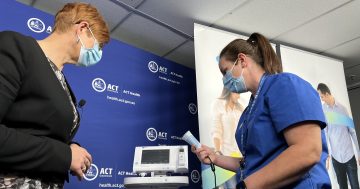
Health Minister Rachel Stephen-Smith and clinical nurse consultant at Calvary Hospital Rowena Hogan discuss the DHR rollout. Photo: Lottie Twyford.
An update on the rollout of the Digital Health Record (DHR) has picked up hundreds of medication and script errors in the past three months.
These included 428 medications being replaced after a warning was given to check dosage, 6651 medications being updated after a warning the drug contained an ingredient the patient was allergic to, 4640 duplicate orders being removed, and 11,286 duplicate therapy orders being removed between 12 November 2022 and 11 February 2023.
Health Minister Rachel Stephen-Smith provided the data in the Legislative Assembly today (30 March), stating it proved the value of moving to a digital record system.
“In providing these figures, I want to emphasise that medication safety safeguards have previously been in place, particularly through manual checking and reconciliation,” she said.
“But the efficiency of the DHR is saving effort as well as increasing patient safety.”
The digital system has been implemented across all ACT Public Health Services, including Canberra’s hospitals, community health centres and Walk-in Centres, and has replaced about 40 existing systems.
Ms Stephen-Smith said the DHR system had also resulted in a reduction of extra blood tests and was giving people more access to their pathology results.
“91.85 per cent of results are released to MyDHR within one day [of being confirmed] and become accessible to patients,” she said.
“And more than 20,000 patients have avoided additional blood draws because the Digital Health Record has made it possible for clinical staff to add tests to the list for blood that has already been taken.”
It’s hoped the system will also allow for better cross-border medical care as Canberra provides health services for many people in southern NSW.
NSW is currently arranging its own state-wide single digital patient record system, with the first implementation site identified as the Hunter New England area.
But Ms Stephen-Smith said the Territory was making a case to see the system sent south.
“We have been making a case that Southern NSW should be the next cab off the rank to provide better integration across the ACT and surrounding region,” she said.
“[This] provides an opportunity for partnership arrangements that will support an integrated patient-centred health care system.”
Privacy and security of people’s data were stressed, especially in light of recent reports of alleged patient privacy breaches within Canberra Health Services.
People cannot choose whether their information is held in the DHR, as it is now a requirement of health services.
But Ms Stephen-Smith said there were additional measures in place that made breaches of privacy more difficult, particularly for access to mental health treatment and care.
“Sensitive patient information such as mental health or sexual health interactions is stored behind something called ‘break the glass’ functionality,” she said.
“This means that sensitive health records are in a secure area that clinicians can only access if they have a legitimate reason for doing so.
“Access to this information requires additional steps to just clicking on a record.”
The DHR rollout has not been easy with staff expressing their frustration at having to learn a new system when they’re already under pressure and incorrect notifications about appointments being sent to 75,000 people.
Shadow Health Minister Leanne Castley pointed out it took weeks for live data on wait times at emergency departments to come online through MyDHR.
She accused the government of only providing Canberrans with positive updates about public health.
“The government can’t give us any data on outpatient waiting times until May, and even then, it’s not clear it will be current,” Ms Castley said.
“Ms Stephen-Smith claims she is committed ‘to providing as much information as possible to the public to ensure there is transparent information being given to the community about their public health services’. At the same time, the government is refusing to disclose information on the Digital Solutions Division, which is implementing DHR.”
Ms Stephen-Smith acknowledged there would “continue to be bumps in the road”, but it was still early days.
“The focus for the future of the Digital Health Record will be working with all stakeholders to optimise the system and continually improve to ensure public health services are supported to provide quality person-centred care through digital innovation,” she said.
The Australian Nursing and Midwifery Union was also contacted for comment.





















